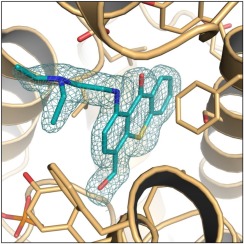Molecular and Biochemical Parasitology ( IF 1.5 ) Pub Date : 2020-02-03 , DOI: 10.1016/j.molbiopara.2020.111257 Meghan Guzman 1 , Anastasia Rugel 1 , Reid S Tarpley 2 , Xiaohang Cao 3 , Stanton F McHardy 2 , Philip T LoVerde 4 , Alexander B Taylor 5

|
Hycanthone (HYC) is a retired drug formerly used to treat schistosomiasis caused by infection from Schistosoma mansoni and S. haematobium. Resistance to HYC was first observed in S. mansoni laboratory strains and in patients in the 1970s and the use of this drug was subsequently discontinued with the substitution of praziquantel (PZQ) as the single antischistosomal drug in the worldwide formulary. In endemic regions, multiple organizations have partnered with the World Health Organization to deliver PZQ for morbidity control and prevention. While the monotherapy reduces the disease burden, additional drugs are needed to use in combination with PZQ to stay ahead of potential drug resistance. HYC will not be reintroduced into the schistosomiasis drug formulary as a combination drug because it was shown to have adverse properties including mutagenic, teratogenic and carcinogenic activities. Oxamniquine (OXA) was used to treat S. mansoni infection in Brazil during the brief period of HYC use, until the 1990s. Its antischistosomal efficacy has been shown to work through the same mechanism as HYC and it does not possess the undesirable properties linked to HYC. OXA demonstrates cross-resistance in Schistosoma strains with HYC resistance and both are prodrugs requiring metabolic activation in the worm to toxic sulfated forms. The target activating enzyme has been identified as a sulfotransferase enzyme and is currently used as the basis for a structure-guided drug design program. Here, we characterize the sulfotransferases from S. mansoni and S. haematobium in complexes with HYC to compare and contrast with OXA-bound sulfotransferase crystal structures. Although HYC is discontinued for antischistosomal treatment, it can serve as a resource for design of derivative compounds without contraindication.
中文翻译:

血吸虫寄生虫中海硫酮药物作用的分子基础。
Hycanthone(HYC)是一种退休药物,以前用于治疗由曼氏血吸虫和血吸虫感染引起的血吸虫病。首次在曼氏沙门氏菌中观察到对HYC的抗性1970年代的实验室菌株和患者中,此药的使用随后被停止使用,吡喹酮(PZQ)替代了全世界处方中的单一抗血吸虫病药物。在流行地区,多个组织已与世界卫生组织合作,为控制和预防发病率提供了PZQ。虽然单一疗法可减轻疾病负担,但仍需要与PZQ组合使用其他药物,以保持潜在的耐药性。HYC不会作为组合药物重新引入血吸虫病药物配方中,因为它被证明具有有害特性,包括诱变,致畸和致癌活性。Oxamniquine(OXA)用于治疗曼氏葡萄球菌在HYC的短暂使用期间(直到1990年代),在巴西发生了感染。已证明其抗血吸虫药的功效与HYC的作用机理相同,并且不具有与HYC相关的不良特性。OXA在具有HYC耐药性的血吸虫菌株中显示出交叉耐药性,并且两者均为前体药物,需要蠕虫中的代谢活化为有毒的硫酸盐形式。目标激活酶已被鉴定为磺基转移酶,目前被用作结构指导药物设计程序的基础。在这里,我们表征了曼氏沙门氏菌和血生沙门氏菌的磺基转移酶与HYC配合使用,可与OXA结合的磺基转移酶晶体结构进行比较和对比。尽管HYC不再用于抗血吸虫病治疗,但它可以作为衍生化合物设计的资源而没有禁忌症。



























 京公网安备 11010802027423号
京公网安备 11010802027423号